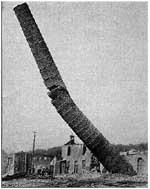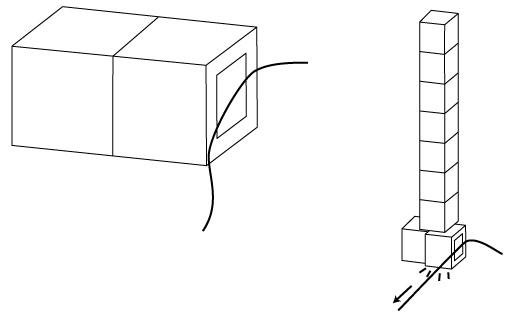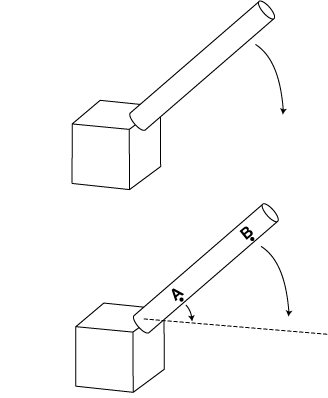Physics in the Toy Room: Toppling Towers

In order to topple a brick chimney, the base is usually knocked out with dynamite or a bulldozer. This is a chimney falling in Glasgow. See the “To find out more” section for links to other pictures and videos.
What you Need
- Set of square blocks
- String (about a meter)
- Adhesive tape
What to Do*
- Use the tape to firmly attach a piece of string to the side of a block. Put this block on a hard surface, right next to another block. As shown in the picture, the string side of the first block should face outward. These two blocks will form the base of your tower.
- Stack the blocks on top of the base and make a tall (but sturdy) tower. Then topple the tower by pulling on the string.
- Notice the way the tower falls. There should be a point where the tower bends and breaks as it falls to the floor. Build and topple the tower again, watching carefully. Where does the break occur? Does the top section of the tower fall forward or backward?

Left: Two blocks placed close together form the base of the tower.
Right: Pull on the string to make the tower fall to one side.
What’s Going On?
Why does the tower bend and break? Think for a minute about why things break in general – such as a dish that falls on the floor. The dish breaks because the pieces experience forces that push or pull them in different directions than their neighbors. These forces are stronger than the bonds that hold the dish together.
This is similar to why the tower bends and breaks – different parts of the tower experience different forces and the forces pulling the tower apart are stronger than the forces holding the tower together. This effect is seen dramatically in pictures that show brick chimneys falling.
Where do these different forces come from?

Top: A rod rotating around its base as it falls.
Bottom: A point near the base of the rod (A) has the same amount of time to travel a short distance as a point near the end of the rod (B) has to travel a much longer distance.
The rod rotates around the base as it falls – which means that the top end of the rod accelerates faster than any other part of the rod. This makes sense if you look at the distance that each point on the rod has to travel before it hits the ground.
But in order for the end of the rod to accelerate as required, the whole rod has to be rigid and straight under the forces pulling it to the ground. Otherwise the falling end will lag behind the rest of the rod.
Towers of blocks and chimneys fall just like the rod – except that the forces holding the blocks (or bricks) together are not strong enough to make the falling end accelerate like the rod. This causes the top section to lag behind the rest of the tower and seem to bend backward.
After the tower breaks, the top of it falls with acceleration only due to gravity. However, the falling end of the (now shorter) tower falls with the acceleration from gravity plus the acceleration from the rotation – which means that it hits the ground first.
Try This!
- Make and topple towers of different heights. How does the breaking point change? At what height do you start seeing a definite breaking point?
- Try this activity with rectangular but non-square blocks, what effect does this have?
- Stack the blocks until the tower collapses naturally. Does the bending and breaking still happen?
More Information
- The Falling Chimney Web Page
- Roachdale Observer: Public all fell for the man in white
- Pillowtex chimneys topple (includes video)
- The Giant Towers Fall (video)
- Old house being crushed by an excavator (video)
*This activity was inspired by: G. U. Varieschi and I. R. Jully, “Toy Blocks and Rotational Physics,” Phys. Teach. 43 (2005) 360-362.











